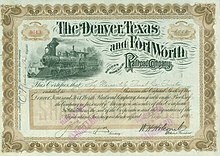Colorado and Southern Railway
This article includes a list of general references, but it lacks sufficient corresponding inline citations. (May 2021) |
standard gauge | |
| Previous gauge | 3 ft (914 mm) |
|---|---|


The Colorado and Southern Railway (reporting marks C&S, CS) was an American Class I railroad in the western United States that operated independently from 1898 to 1908, then as part of the Chicago, Burlington and Quincy Railroad until it was absorbed into the Burlington Northern Railroad in 1981.
The railway began as the consolidation of bankrupt railroads in 1898. The
At the end of 1970 it operated 692 miles of road on 1116 miles of track; that year it reported 1,365 million ton-miles (1,993 million tkm) of revenue freight. In 1980 route-miles had dropped to 678 but ton-miles had ballooned to 7,230 million ton-miles (10,560 million tkm): Powder River coal had arrived.
C&S was also the parent company of the Fort Worth and Denver Railway, which ran from a connection at Texline south and east into Texas. The FW&D was established as a separate company because Texas law required that railroads operating within its borders must be incorporated within that state.

Narrow gauge
The Colorado and Southern
The Gilpin Railroad (earlier the Gilpin Tramway Company) was a 2 ft (610 mm) narrow gauge railway in Gilpin County operating from 1887 to 1917. However, on June 27, 1906, the Gilpin had been sold to the Colorado and Southern.[1]
Downfall of the narrow gauge

The Colorado and Southern narrow gauge was slowly abandoned piece by piece in the 33 years between 1910 and 1943. The first line to close was part of the Gunnison Line between Hancock and Quartz. This included Alpine Tunnel, although rail was not removed until the 1940s. The isolated segments between Quartz and Gunnison and Gunnison to Baldwin were leased and later sold to the
Narrow gauge today



Not much of the narrow gauge survives today. There are five surviving Locomotives:
Predecessor railroads
The following lines were consolidated between 1890 and 1900 to form the C&S:
- Canon de Agua Railroad
- Cheyenne and Northern Railway
- Chicosa Canon Railway
- Colorado Central Railroad
- Denver, Cripple Creek and Southwestern Railroad

- Denver, Leadville and Gunnison Railway
- Denver, Marshall and Boulder Railway
- Denver and Middle Park Railroad
- Denver, Texas and Fort Worth Railroad
- Denver, Texas and Gulf Railroad
- Georgetown, Breckenridge and Leadville Railway
- Greeley, Salt Lake and Pacific Railway
- Leadville Mineral Belt Railway
- Road Canon Railroad
- Union Pacific, Denver and Gulf Railway
See also
- Gilpin tramway
- Overton, Richard C. (1965). Burlington Route, a History of the Burlington Lines. Knopf.
- Drury, George H. (1991). The Historical Guide to North American Railroads. ISBN 0-89024-072-8.
References
- ISBN 0-87108-045-1.
- ^ Littleton, colo (Topographic map). 1:31,650. 7.5 Minute Series. Reston, VA: United States Geological Survey. 1942. Retrieved Jan 8, 2022.
External links
- Colorado Historical Society: C&S Collection
- Colorado and Southern Railway from the Handbook of Texas Online
- Fort Worth and Denver Railway from the Handbook of Texas Online
- Historic American Engineering Record (HAER) No. CO-56, "Colorado and Southern Railway Denver Roundhouse Complex, Denver, Denver County, CO", 27 photos, 1 measured drawing, 12 data pages, 2 photo caption pages
- HAER No. CO-58, "Cherry Creek Railroad Bridge, Denver, Denver County, CO", 8 photos, 5 data pages, 1 photo caption page
